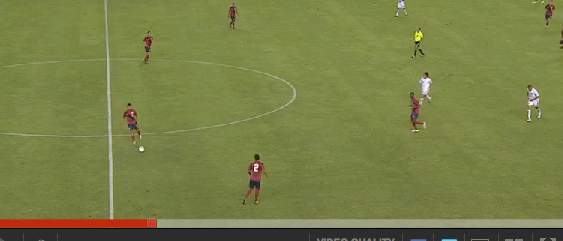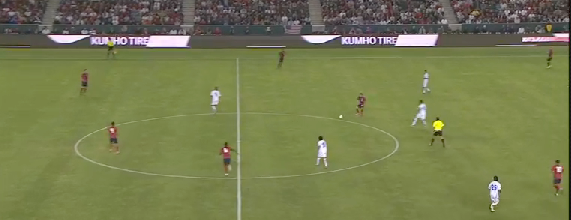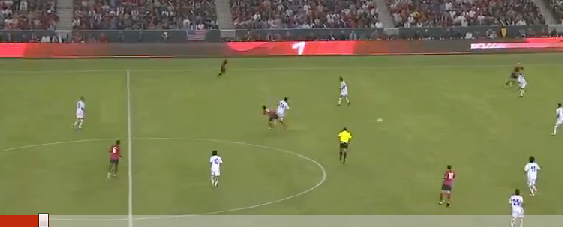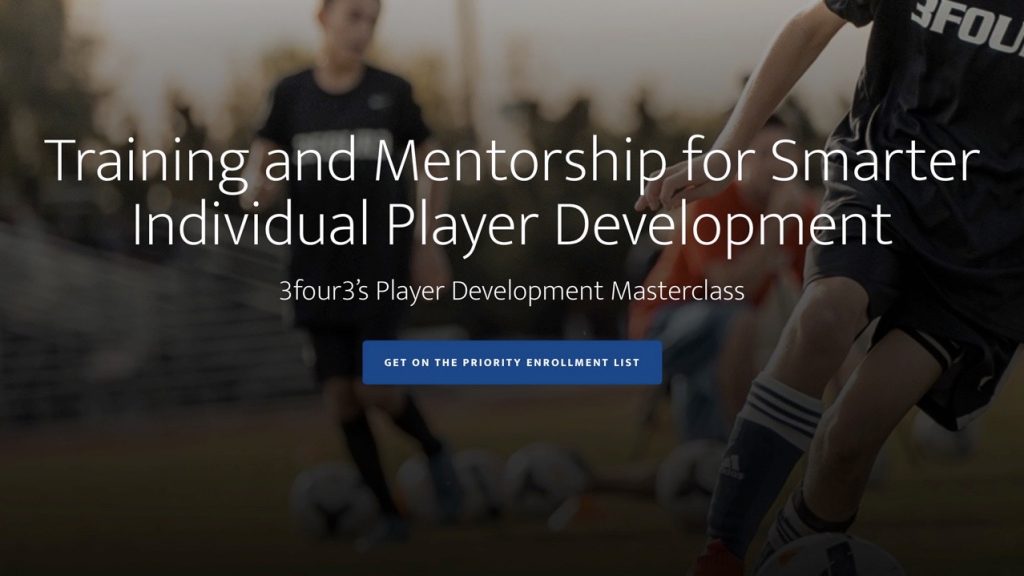This is a guest post by Jacques Pelham. You can find more of his soccer writing at the Football Garden.
On Friday, the US showed signs of progress and promise through its possession play and aggressive tactics without the ball. The revamped central midfield looked far superior as compared to the game against Mexico and provided optimism for the future progress of the US team under Klinsmann. However, the team’s lack of quality at the wide positions and overzealous tendency to play forward demonstrated the vulnerability of a team that is still adapting to the more sophisticated player responsibilities required under the system that Klinsmann is implementing. Thus, a US first half characterized by inspiring multi-touch possession sequences, high pressure without the ball, and obvious goal scoring chances devolved into a far less organized and disciplined performance in the second half that allowed Costa Rica to create opportunistic chances and score the game winning goal.
The Opposition: Costa Rica
Despite achieving an earned reputation of being the 3rd or 4th best team in CONCACAF, the Costa Rica team on the field Friday night was weakened and inexperienced. Costa Rica was without several regular starters and is in the midst of replacing interim coach Ronald Gonzalez before Friday’s game. Costa Rica looked to sit deep and wait for US mistakes/fatigue before moving forward through counter attacks. Costa Rica withstood the initial US pressure and capitalized on the US’s lack of finishing and consistency by scoring a deserved 2nd half goal that stood as the game winner.
Tactics: Makings of an Identity?
The US pressured Costa Rica high up the field throughout the game and the US players appeared to be well instructed with regards to their roles in pressuring/recovering the ball. Interestingly, while offensively the US’s shape was a 4-1-4-1/4-3-3, without the ball the US formed into a 4-4-2 with Donovan joining Altidore to press in the forward line and Edu stepping forward to become even with Torres. This shifting shape between offense and defense worked well in large part due to Donovan’s work rate and ability to drop into the attacking midfield space with the ball and press to become the highest US player up the field without the ball. The US pressure was effective, particularly in the first half when Costa Rica was completely unable to move players forward with possession.
The possible flipside of Klinsmann’s attacking directions is that with the ball, the U.S. showed an increasing lack of patience in build up and selecting attacking opportunities. The wide US players in particular were overzealous in playing forward which led the US to become out of balance and disorganized in the second half. This ultimately led to the poor 2nd half performance and the disappointing result. Moving forward, Klisnmann must instill an appreciation for the balance between the strategic importance of maintaining possession if the team adopt a high pressure system without the ball.
One point regarding the 4-3-3/4-4-2 shape is that playing with a back 4 may have been unnecessary and a tactical mistake. Since Costa Rica played with two forwards, the US could have lined up with a back three (possibly bringing in Ream instead of one of the outside backs?) in a 3-4-3 system. This is a tactic that has been used by Marcelo Bielsa with Chile and Athletic Bilbao and recently by Barcelona in their domination of Villareal. A 3-4-3 shape would maintain a numerical superiority in the back while pushing an additional player into the midfield, either in the #10 role behind the striker or as a wide midfielder a la Dani Alves. Given the preference of CONCACAF teams of playing a 2 striker system (including Mexico) this may be a system worth testing.

Finally, Torres’ performance was far superior to that of any US midfielder in recent memory. Klinsmann should be applauded for recognizing Torres’ quality and for making the decision to start Torres in a central position after making the mistake of using him as an outside winger against Mexico.
The US Central Midfield: Vast improvement
The key deficiency in the match against Mexico was the inability of the central midfielders to dictate the US buildup and create attacks through possession. The central midfield trio of Beckerman-Jones-Bradley was replaced by Edu-Torres-Donovan for the Costa Rica game. In the first half, the play of Torres and Donovan brought the US’s passing and possession game to a different level as compared to any US performance in recent memory.
Torres’ play was the main difference. His ability to receive the ball in tight spaces and make correct decisions allowed the US to keep possession and initiate attacks without resorting to low-probability long passes. His first touch and passing range was the best of anyone on the field and his situational awareness was impressive. Most importantly, his first touch and timely decision-making allowed the US to keep the ball moving quickly and open up gaps in the Costa Rica midfield and defense. Torres demonstrated the extremely important understanding of when to make simple horizontal/backwards passes to players in space to reset the buildup and when to look for a decisive pass forward to create dangerous attacks. Finally, Torres worked continuously on defense pressuring from the front and back with speed and intent and won the ball back single-handedly on several occasions.


The play of Donovan and Edu complimented Torres, although both players showed weaknesses that detracted from the US’s performance. Donovan’s passing was consistent for the most part and he was dangerous making bursting runs through the midfield although he failed to finish what appeared to be a relatively simple chance in front of goal. In addition, his spacing and defensive work rate were effective.
Edu also made valuable contributions, intercepting several passes and pressuring the CRC midfielders to good effect. However, at times Edu’s decision making was overly reactive which resulted in poor positioning and a failure to contain or influence Costa Rica’s options. On the ball, Edu looked comfortable when he was afforded space and time and showed quality in moving the ball quickly so as not to detract from the US rhythm and buildup. Of concern was Edu’s lack of composure receiving and distributing the ball under pressure, a characteristic that will be problematic against higher quality opposition.
The Wide Players: Volatility leads to failure
The performances of Shea, Rogers, Castillo, and Chandler lacked sophistication and created instability within the US system. With the central midfield dictating possession and tempo of the game, every US player had more touches and more opportunities to influence the US performance. Unfortunately, as Costa Rica settled in and the game progressed, the wide players showed an inability to consistently make the right choice given the situational challenges and overall context of the game.
All of the outside players were too eager to play forward, often showing poor situational awareness and underestimating the risks inherent in preferring direct dribbling or long passes as opposed to finding a simple short pass to maintain possession. Shea and Rogers were too eager to run forward with and without the ball while Castillo and Chandler both played dangerously inaccurate short and long passes. The latter tendency is particularly concerning given the necessity of outside backs to make simple and successful decisions repeatedly throughout the game.
The wide players’ tendencies described above created a fundamental disunity between the deliberate play of the US central midfielders and the volatile decisions of the wide defenders/attackers. While Torres in particular performed well to patiently manage the rhythm of the US buildup and transition in attack in the first half, by the middle of the second half mistakes by the wide players consistently caused the US to lose possession and become stretched/out of balance. This trend led to the systematic failure by the US to keep possession as it had done in the first half and provided counterattacking opportunities to Costa Rica, one of which Costa Rica capitalized upon to score the game’s lone goal.
Of particular concern was the US’s lack of patience and commitment to the deliberate buildup and possession that had served them well in the first half after conceding the goal. The volatility and lack of patient collective buildup that led to the Costa Rica goal became even worse as the US attempted to equalize. Almost immediately, the US began to look desperate with players choosing to dribble and play long passes forward in vain.
Altidore: Incomplete
Jozy Altidore showed improvement from recent US performances, particularly with regards to his defense work rate and ability to receive possession under pressure. However, his decision-making often led to loss of possession and failure to positively influence the US buildup or attack. Altidore’s faulty decision-making combined with inferior technique compared to most international center forwards will hamstring the US progress. If the US is to progress to become a more complete and sophisticated team, Klinsmann must select/develop a more complete central forward.
Bocanegra/Orozco-Fiscal:
The center back pairing of Orozco-Fiscal and Bocanegra was effective when called upon on defense and generally effective in distribution. Because Costa Rica sat back for most of the game, the key contributions of the center backs were when the United States were in possession. Orozco-Fiscal looked particularly calm and effective distributing the ball. Bocanegra still looks to lack composure in certain situations on the ball and played several poor passes into pressure when he could’ve reset the build up be playing back to Orozco Fiscal or Tim Howard. The goal scoring opportunities came as the result of midfield breakdowns and left the two center backs with little chance at breaking up the Costa Rican chances.

Gary,
Excellent review of he USNT performance.With an eye looking ahead, don’t think we’ll see any of the outside players that started Fri night in our starting line up once qualifying begins. Add Dempsey, Holden, Bedoya, Cherundolo,to the mix. But I like what Klinsi is doing bringing in new players and giving them plenty of time to prove themselves.This will improve the depth of our team in the long run. Too bad this process had not begun already. I agree we still need to find that player that can deliver the goods (goals).
Walt,
This is a post from Jacques.
Excellent post Jacques!
Sorry Jacques. It was a great post.
Excellent analysis as always….I’ve re-posted it on my sons academy page. Question, did anyone see the USL championship game yesterday?…I stumbled upon it trying to find some REAL soccer and it was dreadful to watch! Why does this league even exist!?
I know this post was by Jacques but this question is directed toward Gary and his thoughts.
Through out the game you heard the commentators speak of things about players with dual citizenship. Is this going to be a point of emphasis with Klinsmann in an attempt to expand the player base? It almost appears as if he is being very intentional about this. Looking to fringe players from other countries who can in fact play for the US. Is this something you think he will start exploiting more?
If so do you know any players off the top of your head who would be targets to improve this squad?
Hi Henry,
I don’t know what Klinsmann is thinking with respect to this issue. My point of view is simple: select what one believes are the best players and forget about the ‘extra soccer’ circumstances.
It seems lots of countries, not just the US, have accelerated these same efforts. And why not?
I am also of the opinion that there is a larger probability these players are of higher quality simply because they avoided the disaster here. So yes, I think it’s likely the duel citizenship trend will continue.
Lastly, I don’t know of any eligible players outside of who’s been called up already.
What are your thoughts?
My thoughts……
Well……
I kinda feel as if this is one of the areas where the US benefits from being the “melting pot” I say that because our country and culture is very diverse and I feel that our National Team should reflect that. I believe that if our NT is as diverse as the country it represents and embraces great players from around the world that can play for the US and WANT to play for the US then it will only benefit the National Team program. The US Soccer Fed has to be diligent in figuring out how to attract those players………
Agreed.
I have a player in mind but won’t spoil it for Gary!